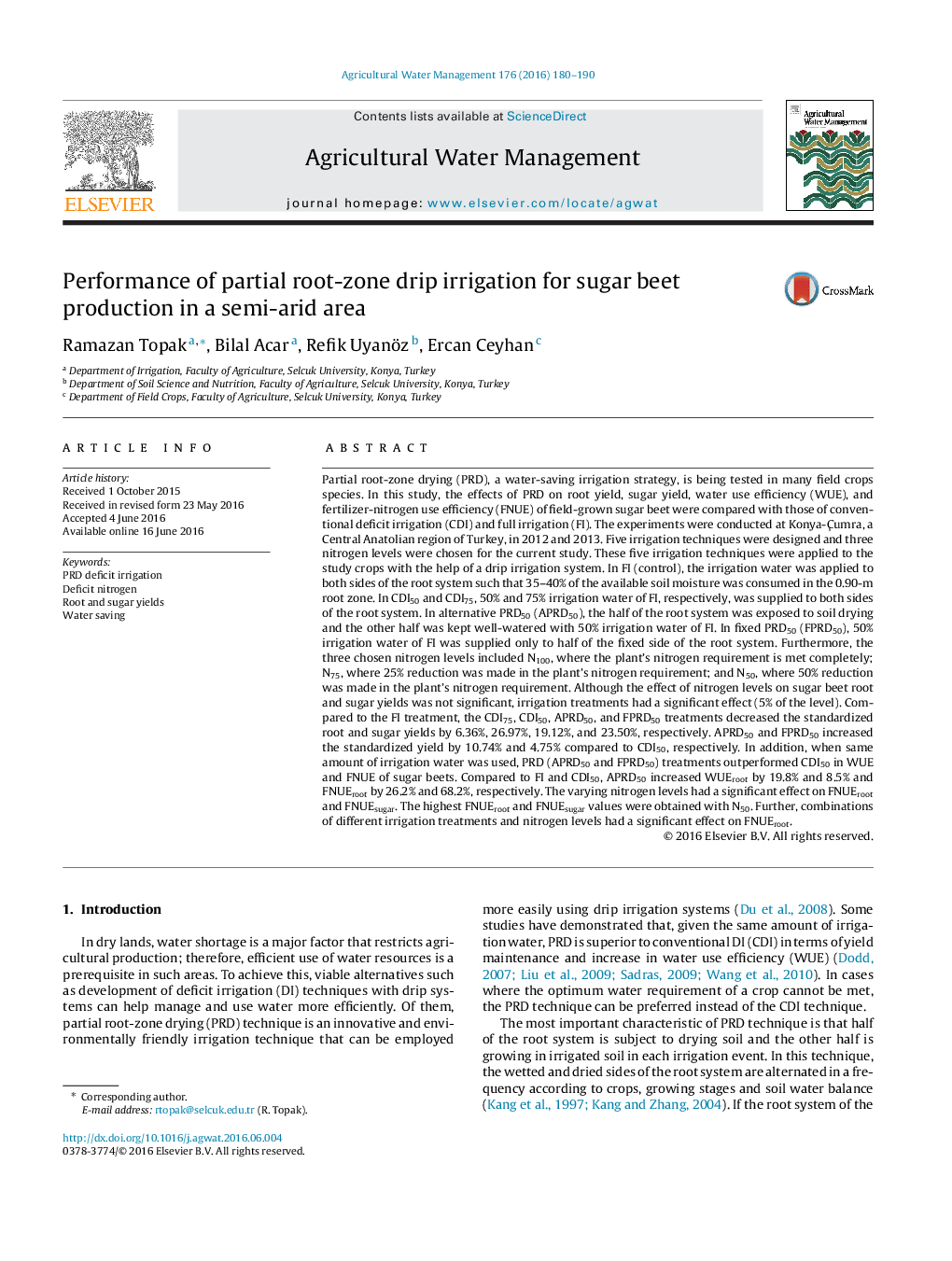| کد مقاله | کد نشریه | سال انتشار | مقاله انگلیسی | نسخه تمام متن |
|---|---|---|---|---|
| 4478246 | 1622904 | 2016 | 11 صفحه PDF | دانلود رایگان |
• Response of sugar beet plant to the partial root drying irrigation by drip irrigation system.
• Water savings in deficit irrigation techniques.
• Irrigation and nitrogen fertilizer use efficiencies under partial root drying irrigation.
• Alternative partial root drying superior to conventional deficit irrigation under same applied water.
Partial root-zone drying (PRD), a water-saving irrigation strategy, is being tested in many field crops species. In this study, the effects of PRD on root yield, sugar yield, water use efficiency (WUE), and fertilizer-nitrogen use efficiency (FNUE) of field-grown sugar beet were compared with those of conventional deficit irrigation (CDI) and full irrigation (FI). The experiments were conducted at Konya-Çumra, a Central Anatolian region of Turkey, in 2012 and 2013. Five irrigation techniques were designed and three nitrogen levels were chosen for the current study. These five irrigation techniques were applied to the study crops with the help of a drip irrigation system. In FI (control), the irrigation water was applied to both sides of the root system such that 35–40% of the available soil moisture was consumed in the 0.90-m root zone. In CDI50 and CDI75, 50% and 75% irrigation water of FI, respectively, was supplied to both sides of the root system. In alternative PRD50 (APRD50), the half of the root system was exposed to soil drying and the other half was kept well-watered with 50% irrigation water of FI. In fixed PRD50 (FPRD50), 50% irrigation water of FI was supplied only to half of the fixed side of the root system. Furthermore, the three chosen nitrogen levels included N100, where the plant’s nitrogen requirement is met completely; N75, where 25% reduction was made in the plant’s nitrogen requirement; and N50, where 50% reduction was made in the plant’s nitrogen requirement. Although the effect of nitrogen levels on sugar beet root and sugar yields was not significant, irrigation treatments had a significant effect (5% of the level). Compared to the FI treatment, the CDI75, CDI50, APRD50, and FPRD50 treatments decreased the standardized root and sugar yields by 6.36%, 26.97%, 19.12%, and 23.50%, respectively. APRD50 and FPRD50 increased the standardized yield by 10.74% and 4.75% compared to CDI50, respectively. In addition, when same amount of irrigation water was used, PRD (APRD50 and FPRD50) treatments outperformed CDI50 in WUE and FNUE of sugar beets. Compared to FI and CDI50, APRD50 increased WUEroot by 19.8% and 8.5% and FNUEroot by 26.2% and 68.2%, respectively. The varying nitrogen levels had a significant effect on FNUEroot and FNUEsugar. The highest FNUEroot and FNUEsugar values were obtained with N50. Further, combinations of different irrigation treatments and nitrogen levels had a significant effect on FNUEroot.
Journal: Agricultural Water Management - Volume 176, October 2016, Pages 180–190
